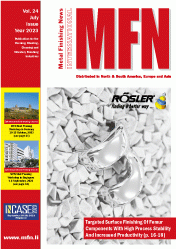E-Archive
Shot Peening in the Automotive Industry
in Vol. 24 - July Issue - Year 2023
Shot Peening and Material Defects in AMed Parts

The interest of automotive toward additive manufacturing (AM) is increasing day after day. Indeed, it is true that the production rate of AM processes are not comparable with traditional processes today, and that it is not sustainable for mass production. However, it is also true that the incredible freedom offered by AM is quite attractive for the design engineers, since it is possible to develop and implement light weight solutions or new materials that result in improved performances, reduced energy consumption, and less waste of raw materials.
Topological optimization, once considered a sort of “academic exercise”, is now a method commonly used thanks to AM, since the shapes deriving from this method can be obtained with AM processes. I can also mention the possibility of designing and producing lattice functional materials, with peculiar properties related to their structure increasingly used to improve the heat transfer and then reduce the energy dissipation.
However, AM also generates new problems. Indeed, it is well known that the AMed parts have several internal defects, which are likely to be the points where a possible damage mechanism will originate: quick browsing of technical and scientific literature is enough to understand that fatigue cracks in AMed parts frequently start from an internal defect, and this is quite different from traditional processes.
However, the surface state is also special and, in most cases, unacceptable for practical applications: a post-treatment for surface improvement is needed, and shot peening is one of the ideal candidates. In recent years, more than one paper has been published reporting the results of fatigue tests on AMed samples, and reporting that the fatigue strength and durability after shot peening treatment are many times better than those of specimens under as-built conditions. But what is more interesting is that by applying shot peening, the thermal treatment can be skipped, at least in terms of the fatigue performance.
However, the shot peening application is not straight: the initial state of the AM surfaces is so different from the traditional processes that it is impossible to apply the same combination of processing parameters to achieve satisfactory results. In other words, the application of shot peening to AMed parts requires research and analysis of the as-built surfaces, and the characterization in terms of the defect dimension distribution to correctly orient the choice of the set of parameters. In fact, the surface state of AMed parts is characterized by a high surface roughness and a remarkable defect rate, and it is strongly influenced by the AM parameters, such as the deposition direction and the laser parameters.
This means that there is the need of research and additional studies to understand the relation between the AM process parameters and the shot peening parameters, with a view to obtaining a valuable residual stress field and a fine surface finishing, and optimizing the fatigue behaviour of the treated parts as a function of the material and the manufacturing parameters.
Most of the readers probably think that this needs extensive and expensive experiments, but the appropriate use of simulation can reduce the effort.
In any case, the benefits of this investment in the mid-term will be remarkable and will probably make the difference.
by Mario Guagliano
Contributing Editor MFN and
Full Professor of Technical University of Milan
20156 Milan, Italy
E-mail: mario@mfn.li



























